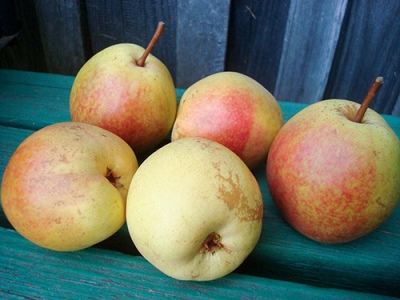
- Authors: Chizhov S.T., Potapov S.P., Agafonov N.V., Isachkin A.V., Vorobiev B.N., Matushkin A.G., Susov V.I., Khanzhiyan I.I. (FGBOU VO RSAU-Moscow Agricultural Academy named after K.A.Timiryazev)
- Year of approval: 2001
- Fruit weight, g: 125
- Ripening terms: late summer
- Fruit picking time: in the second-third decade of August
- Appointment: universal
- Growth type: medium height
- Yield: high
- Marketability: good
- Height, m: 4-5
It is always very important to choose the right variety of a particular crop for your garden. So, the winter-hardy Rogneda pear can be a good option for a private plot. When growing this crop, gardeners will not have problems with care, and delicious fruits are almost guaranteed.
Breeding history
A large group of domestic specialists worked on the selection of culture: Chizhov S.E., Susov V.I., Isachkin A.V., Potapov S.P., Khanzhiyan I.I. and others. The work was carried out on the basis of the A. K. A. Timiryazeva. The Rogned pear was entered into the State Register in 2001.
Description of the variety
The tree is medium-sized, it can grow up to 4–5 m. It has a wide-pyramidal crown, it is dense, but at the same time compact. The main branches grow at an angle of almost 90 °.
The leaves are medium in size, obovate, the edges of the leaves are serrated. The petioles are of medium thickness and length; stipules are small. Fruits appear on young ringlets.
Fruit characteristics
The pears of the described variety are small, about 125 g each. They have a round shape, sometimes there are flat-round and even wide-rhombic fruits. Pears are painted in a light yellow color, there is no integumentary color, but it can appear as a scarlet blush of a slightly washed out tone.
The color of the flesh is white-beige, the skin is smooth and shiny. Rogneda can also be distinguished by a large number of small subcutaneous dots, as well as by a not very long stalk, which differs in thickness. Rogneda is stored for 10 to 20 days, but if you put the fruits in the refrigerator, then almost 2 months.
Taste qualities
Rogned pears have a juicy, slightly oily flesh. They taste sweet with nutmeg notes. The tasting score on a five-point scale is 4.2.
Ripening and fruiting
The culture is early-growing, the first fruits appear on the tree in the 3-4th year of life. The variety belongs to the late summer, harvesting is possible in the 2-3rd August decade. Fruits reach consumer maturity in late summer - early autumn.

Yield
The variety is characterized by a high yield level. The registered indicators are 140.5 c / ha. Pears are highly marketable.
Growing regions
The culture is zoned for cultivation in the Central region, and it is also allowed to cultivate it in the Moscow region.
Landing
Rogneda saplings, preferably two-year-old, are best purchased in good proven nurseries. The trees should have developed roots and look healthy. Trunk - with a diameter of 1.5 cm. Seedlings with a closed root system can be planted at any time. If the roots are open, the trees adapt longer, it is better to plant them either in the spring, before the beginning of the growing season, or in the fall, but only at least 1 month before.how the cold comes.
The Rogned pear is planted in loam or sandy loam soil. The hole must be prepared in advance, at least 2 months before planting. The pit should be 80 cm wide and 60 cm deep. The excavated soil should be mixed with humus, as well as with mineral fertilizers. Sand should be added to clay soil.
During planting, the roots of the seedling are straightened, laid on the prepared mound in the hole. The tree is carefully covered with earth, trying not to create air pockets. The root collar is placed above the soil surface at a distance of 5 cm.At the end of the procedure, the earth is well tamped, watered, covered with a layer of mulch. We must not forget that the young pear needs a support, to which the seedling is tied.


Growing and caring
Caring for a varietal Rogned pear is quite simple. The culture is distinguished by drought resistance, however, with a lack of moisture, it develops and bears fruit rather poorly. Therefore, proper watering is so important. It is carried out in specially dug grooves to a depth of 15 cm, located around the trunk. After watering, they are covered with earth, the soil around the trunk is loosened and covered with mulch.
Well-timed feeding, contributing to the formation of a good harvest of fruits, also has a positive effect on the Rogneda variety. However, an excess of fertilizers, as well as a lack of fertilizing, sometimes adversely affects the growth and development of the pear. If the tree is planted in prepared and fertilized soil, the pear will not need additional fertilizing for the first three years.




Like any other fruit trees, the pear needs protection from various diseases and pests. When planting a pear on your site, you need to know in advance what diseases you should beware of. To successfully carry out the struggle, it is necessary first to correctly identify the cause of the problem. It is important to distinguish signs of disease from manifestations of the presence of insects, mites, caterpillars and other types of pests.





































































